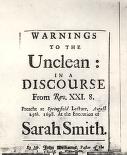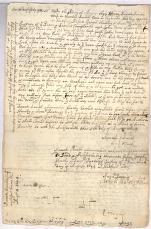|

"Warnings To The Unclean": In A Discourse From Rev. XXI. 8. Preacht at Springfield Lecture, August 25th.1698.

Complaint against John Evans by Sarah Smith
|
Summary and Objective
Students will understand that Murder and "Uncleanliness"constituted capital offenses in the Massachusetts Bay Colony in 1698. Students will learn the method of execution - hanging. From excerpts from the sermon of the religious leader of the community, prior to the execution, students will understand that religious and civic law were intertwined. Students will brainstorm some pros and cons of capital punishment today, learn whether their state has the death penalty today, and role play a state legislature voting on this important issue.
Teaching Plan
Step 1.
Read about the case of Sarah Smith and the Complaint by Sarah Smith made against John Evans who allegedly earlier raped her in the two documents from the digital collection.
Step 2.
Students will prepare a short time line of events from the background explanations of these sources.
Step 3.
Students will read a sampling of the "Warnings" sermon of the Rev. John Williams, noting especially pages 1 through 3,13, 14, 17, 18, 57,58, 60 and 64. Students wll discuss the justification given by Rev. Williams for killing the murderer, and also for providing the opportunity to repent.
Step 4.
Students will discuss what "justice" is, and whether "justice" was done in the case of Sarah Smith.
Step 5.
On the next day, divide students into small groups giving each a task to research on the internet:
1) Does your state have capital punishment? If so, for what crimes? If not, when was it abolished?
2) How many and which states in the USA have capital punishment, and which ones do not? Which states are responsible for most of the executions?
3) How many countries in the world have and do not have capital punishment?
4) What are some of the reasons to support the death penalty?
5) What are some reasons to oppose the death penalty?
6) Are there more whites than non-whites on death row? More males or females? (Remember, Sarah Smith was female).
Students present their research to the class by power point or other means combining a presentation with a chart, map, graph or other visual. On the Amnesty site, search for "Death Penalty." On the Office of Justice Programs site, search for "Capital Punishment Statistics."
Step 6.
Students are encouraged to ask each other questions and then to debate the issue as if they were in a state legislature.
Students could then Vote as legislators whether their state should have or should not have capital punishment. The teacher should decide whether to have a secret ballot or roll call vote.
|




